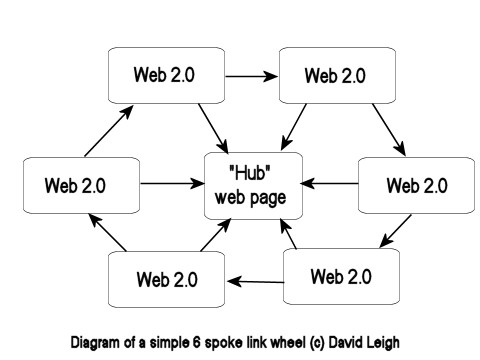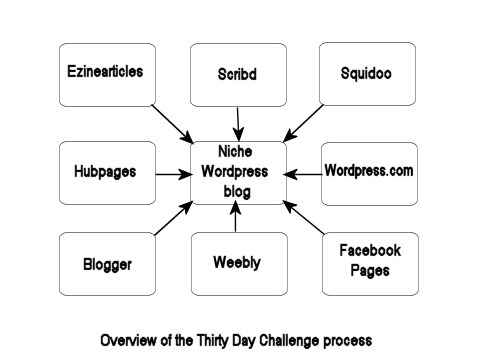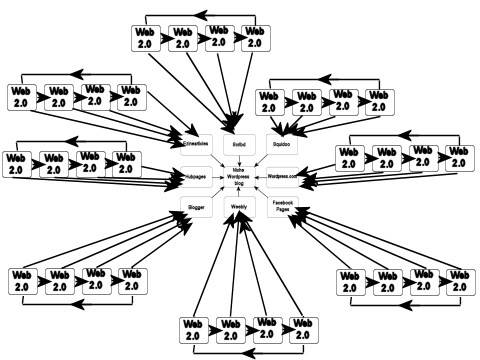Link wheel creation – boost your website’s rankings with your own Web 2.0 link network
February 23, 2010 7:01 pmA recent report in Immediate Edge found that using a paid for link wheel service boosted rankings in a competitive market from #47 on 17th December 2009 to #8 by 7th January.
Having tested the service myself I can vouch for its effectiveness, but it is relatively expensive for what is really a simple idea. I therefore decided to write up the process for a virtual assistant instead; the by-product of it is this post.

Link wheels are similar to “the butterfly” linking model that Michael Campbell talked about in Revenge of the MiniNet. The difference between them is whereas the butterfly consists of a number of self hosted mini websites, the link wheel is usually made up of a single post hosted on Web 2.0 properties, although it can mix both self hosted and Web 2.0 hosted content if preferred.
If you have any concept of Internet Marketing then you’ll appreciate the value of backlinks. A link wheel creates a number of backlinks to another webpage; it consists of a number of “spoke” pages Web 2.0 pages – typically 4 to 7 different properties – that provide one link to the “hub” page that you’re trying to boost in the search engines and a second link to the next “spoke” page in the link wheel.
Over time a number of link wheels can be interlink to further focus the PR on the “hub” page you are trying to boost. While this hub can be a page on your website or blog, I prefer to link to another Web 2.0 site or article.

If you’re familiar with the Thirty Day Challenge model (overview above), where a website is linked to from a variety of Web 2.0 properties, each Web 2.0 property would become a hub for a number of link wheels:

Now that’s starting to look complicated. But it isn’t really – it’s simply process that should be done over time to build up content on the Web 2.0 properties and social bookmark all those Web 2.0 properties (preferably using Traffic Bug or something similar).
In fact, it can get slightly more complicated than that, because if your site needs further link love each of those Web 2.0 properties can then become the hub for a new link wheel.
The advantage of linking to a Web 2.0 property instead of directly to your own website is that there is a degree of separation between the link wheel and your site. If Google picks up on your link wheel your site is less likely to be penalised thanks to the Web 2.0 “buffer” zone.
The problem is that although the task is simple, it is time consuming – most of the time is taken setting up accounts, adding content to the Web 2.0 sites, adding backlinks to the hub and next spoke site and with social bookmarking – hence my need to outsource.
Anyway, in my next post I’ll discuss what Web 2.0 properties to use, and how to go about setting up your first link wheel.
If you’d like a link wheel to be created for you check out my new link wheel creation service.
Tags: dan raine, immediate edge, link networks, link wheels, linkwheels, thirty day challengeCategorised in: internet marketing
This post was written by David


6 Comments
Great post and simple explanation of what is a relatively long winded process
Very simple explanation of link wheels and wheels in wheels.
There is no way you can sell this one for $97
Have to make it more complicated!!!
Need some more sites?
http://livejournal.com
http://blog.com
http://blog.co.uk
http://jimdo.com
http://blinkweb.com
http://blogsome.com
http://freewebs.com
Search for ‘link wheels’ on Google to get even more sites
Thanks for the comments. Thanks for the list Asbjorn, I’ve got a ton of Web 2.0 properties already including all of those – blog.co.uk seem hot on moderating their blogs which means you’re likely to get deleted – and I’ll talk about other types of site you can use in your link wheel next time.
Hi David, nice post. Looking forward learning your next post on the web 2.0 properties you use. Maybe we should meet up once as I´m running by IM business in Barcelona as well.
Take care
Hi Herwin,
Glad you liked the post. I’m always open to meeting up.
David